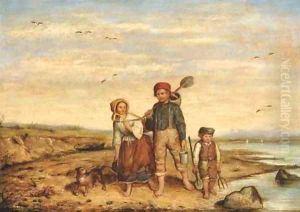Eugen Gustav Dutcker Paintings
Eugen Gustav Dücker, also known as Eugen Dücker, was a prominent Baltic German landscape painter associated with the Düsseldorf school of painting. Born on 29 January 1841 in Arensburg, on the island of Saaremaa (then part of the Russian Empire, now Estonia), Dücker's early life was spent in the serene and scenic surroundings of the Baltic region, which would come to greatly influence his later work.
Dücker received his artistic training at the St. Petersburg Academy of Arts, where he studied from 1859 to 1865. His talent was recognized early on, and he was awarded a scholarship that allowed him to travel and study in Europe. In 1866, he settled in Düsseldorf, Germany, where he became a student of the influential landscape painter Oswald Achenbach. Achenbach's approach to landscape art had a lasting impact on Dücker's style.
Throughout his career, Eugen Dücker became known for his realistic and atmospheric landscape paintings, often depicting the coasts and forests of the Baltic Sea region. His works are characterized by their meticulous attention to detail, a keen observation of light and atmosphere, and a profound sense of mood. Dücker's landscapes not only captured the physical beauty of the natural world but also conveyed the emotional and poetic qualities of the environment he depicted.
In Düsseldorf, Dücker quickly became a respected member of the artistic community and began teaching at the Düsseldorf Art Academy in 1872. He influenced a generation of artists as a professor, holding this position until his death. Among his students were notable painters such as Clara Siewert and August von Wille.
Dücker's artwork was exhibited widely during his lifetime, and he participated in numerous international exhibitions, achieving recognition and awards. His paintings are now part of collections in several museums, reflecting the enduring appeal of his landscapes and his contribution to the art world.
Eugen Gustav Dücker passed away on 6 December 1916 in Düsseldorf. His legacy lives on through his evocative landscapes, which continue to be admired for their naturalistic beauty and emotional depth. His influence extended beyond his own work, as he helped shape a generation of landscape painters through his teaching and mentorship.
